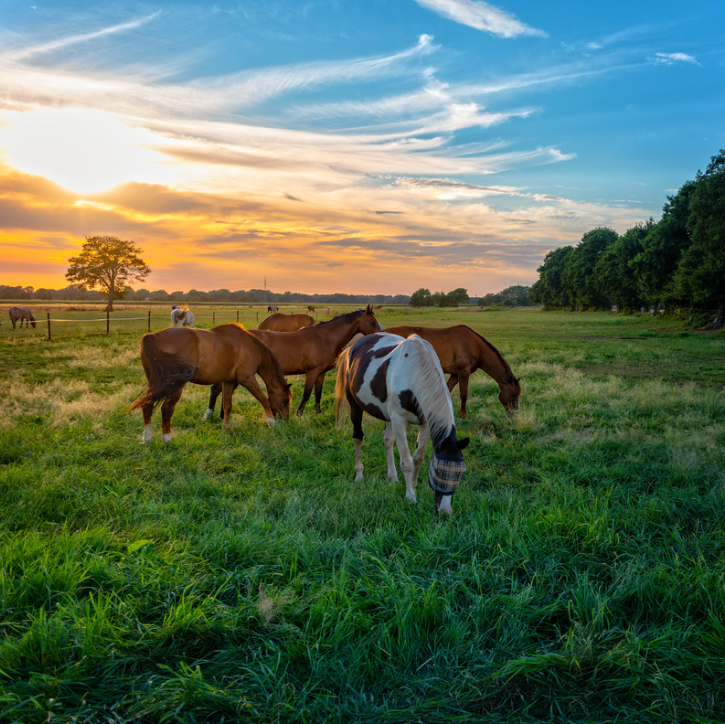Holistic Horsekeeping, Madalyn Ward, DVM
How to have a healthy happy horse.
Volume 28, Number 4
Spring Feeding
Spring is here and for those lucky horses who live in native grass pastures this means a wide selection of herbs and nutritious weeds, plus fresh grass high in omega 3 fatty acids and other nutrients. For those horse living in dry lots or stalls it means finishing up last years hay and grass pellets or bagged feed. Stalled and dry lotted horses miss out on all those cleansing and nutritious plants provided by nature.

You can help out your pasture deprived horse with some well chosen supplements. I prefer to offer springtime herbs free choice so the horse can self select what he needs. I watch horses eating in the pasture and what one horse craves another avoids. It is also the case that horses may seek out certain plants during different weather conditions. They may choose a moistening herb, such as mullein or dandelion root, during drought conditions, and a mild diuretic, such as dandelion leaf, during times of higher humidity.
I have some favorite herbs that I like to rotate through, especially in the spring. I usually put out a hand full of dried herbs a day. If I am putting out a formulated herbal supplement, I always follow the package directions. You can also feed fresh herbs if they are growing in areas that your horse is unable to access. Keep in mind that herbs can be very high in sugar so be cautious if you have a metabolic horse. I believe herbs can still be very helpful for metabolic horses but in very small amounts. For horses that tend to get too fat on spring grass I use Lean Muscle, which helps them safely process carbohydrates.
Dandelion leaves – Dandelion leaves are high in minerals, have a cooling energy and a bitter flavor. Dandelion leaves are anti inflammatory, mildly diuretic, help cleanse the blood, have a mild laxative effect and help with sore joints.
Dandelion root – Dandelion root has a cooling and moistening energy and has a bitter and slightly sweet taste. The root is anti bacterial, anti tumor, mildly diuretic, good for the liver and can lower blood sugar.
Hawthorn – Hawthorn berry is a wonderful herb to support the heart and circulation. It has a slightly warm to neutral energy and a sour and sweet flavor. Hawthorn is a heart tonic, antispasmodic, antioxidant, astringent, nervine and vasodilator. Hawthorn contains B vitamins, Vitamin C, Biotin, Flavonoids, rutin and quercitin.
Juniper berries – Juniper berries have warm to hot, dry energy which makes them an excellent choice in early spring when the weather can still be cool and damp. They have a pungent, sweet flavor. They stimulate digestion, have a strong diuretic action and help with sore joints. Juniper berries provide Vitamin C, Sulphur, Cooper and Molybdenum.
Cleavers – Cleavers in the whole herb form has a similar energy and taste to dandelion leaves. Cleavers is high in many minerals as well as Vitamin C and luteolin. My horses love both herbs. Cleavers can also help clean the lymphatic system and can address minor skin irritations.
I put out free choice kelp for my horses. I use the product, Source, which is designed for horses. I do not exceed the recommended dosage because I do not want to overdose with iodine. I find some horses will not consume free choice salt or eat food that has salt added but will willingly eat Source, which is high in Na and Potassium.
I use a free choice mineral year round called RedCal from NaturalVet. I have a metabolic horse so I use the RedCal plus magnesium. I find my horses will not eat much for a while but then will suddenly eat large amounts when the weather changes. This product can be left out in buckets and is not affected by rain.
I feed blue green algae to my horses year round. I put , on average, 1 tsp of the the algae in the food and my horses love it. Algae is a huge help for horses eating last years hay. AFA algae is harvested in its wild form and when dissolved in water releases the most beautiful rainbow colors. I think this kind of high vibrational energy is what you find in spring grass and is not able to be duplicated with dry herbs.

I suggest reading Equine Herbal and Energetics, by Stacey Small and Andrea Baldwin to help understand the best herbs to offer your horse during different seasons. You may even want to grow herbs or plant herbs along your fence lines where they will not be as easily mowed or grazed down. Your horse will certainly appreciate having herbs to brighten up his diet.
++++ Copyright ++++
Unless otherwise attributed, all material is written and edited by Madalyn Ward, DVM. Copyright (c) 2023 HolisticHorsekeeping.com and Madalyn Ward, DVM. All rights reserved.
If you like the material in this newsletter please let your friends know about it. You may reprint material in other electronic or print publications provided the above copyright notice and a link to http://www.holistichorsekeeping.com is included in the credits.
When you forward this material, please send the entire newsletter. Thanks!
Please also enjoy all of Dr. Ward’s web resources:
http://www.holistichorsekeeping.com
http://www.horsetemperament.com
http://blog.horseharmony.com
https://www.facebook.com/HolisticHorsekeeping
https://www.facebook.com/HorseHarmony